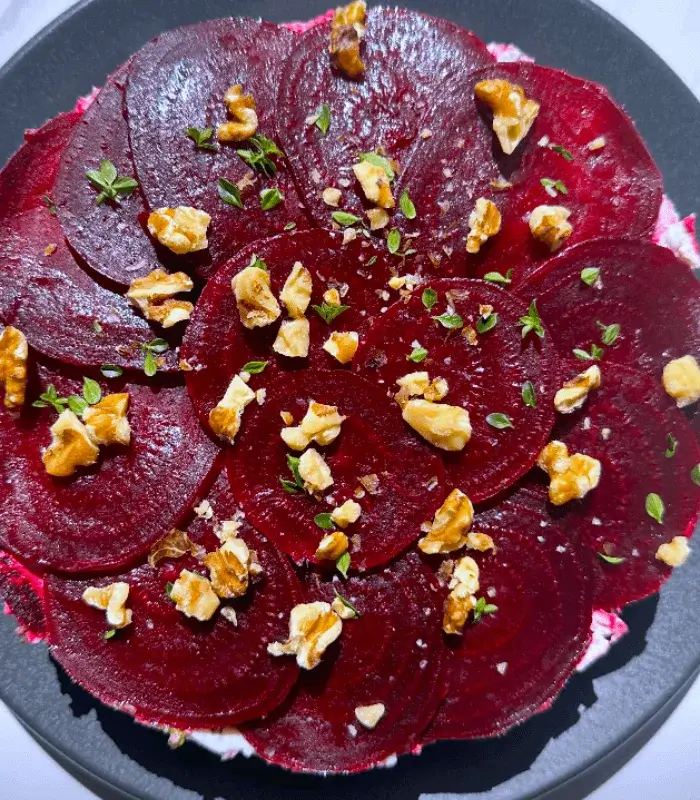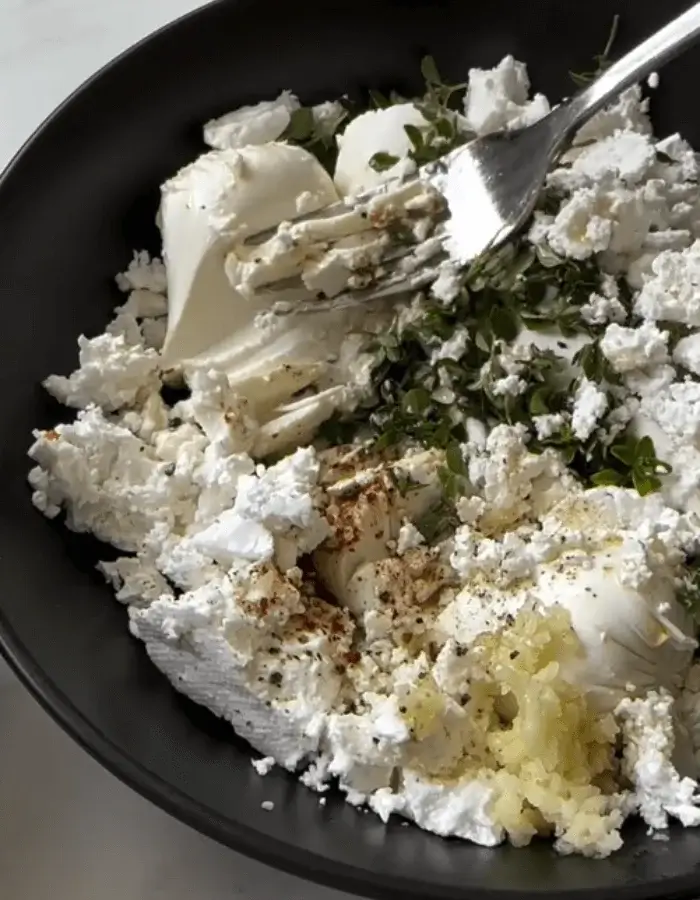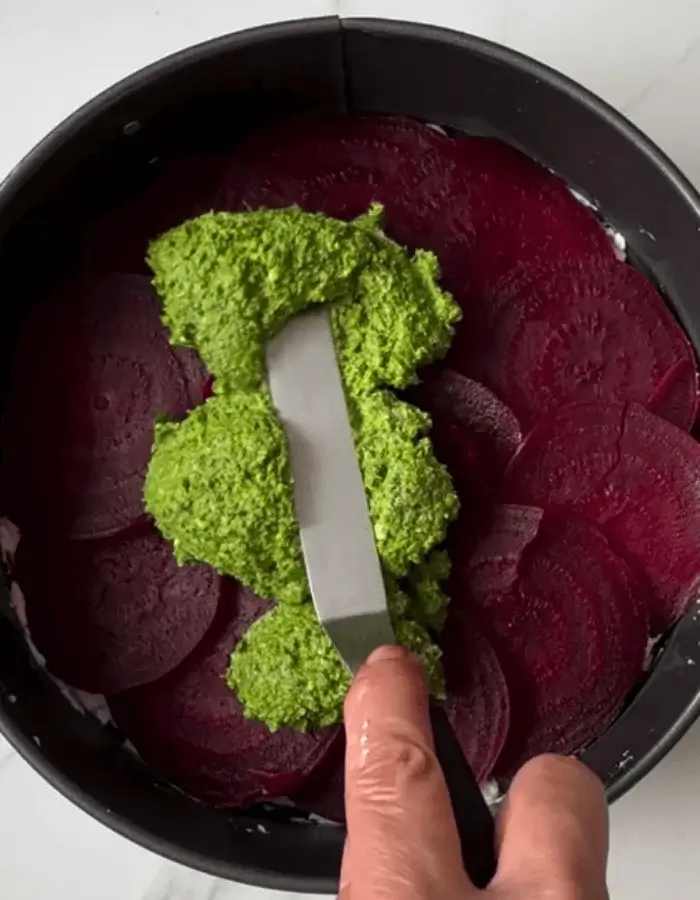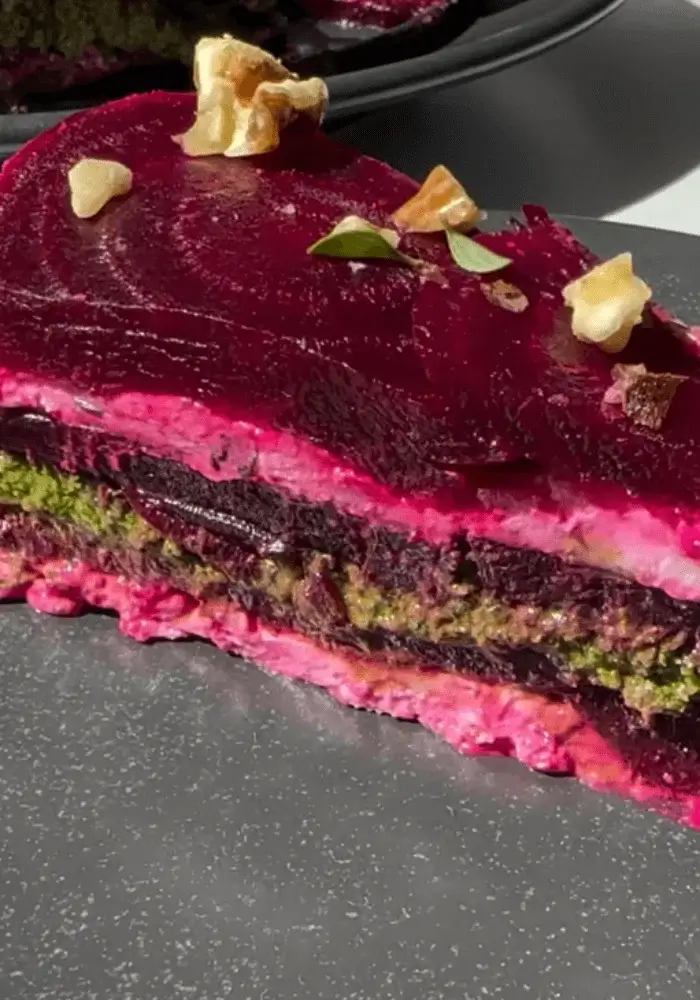Beetroot Terrine with Goat Cheese and Herb Spread
We may earn a commission from recommended products, at no extra cost to you. See Disclosure.
- Large pot
- Mandoline
- Food processor
- 20 cm/8-inch springform pan
INGREDIENTS
- 4 large beets
- ¼ cup/30 grams walnuts, chopped
- 1 tablespoon fresh thyme leaves
Cheese spread:
- 5 ounces/140 grams goat cheese rolls
- 2 garlic cloves, finely chopped
- 3.5 ounces/100 grams goat feta cheese
- 3 tablespoons olive oil
- 2 tablespoons fresh thyme leaves
- Freshly ground black pepper, to taste
Green herb spread:
- 4 cups parsley leaves
- 1 head garlic, about 10 cloves
- ¼ cup olive oil
- 2 tablespoons almond flour
- Salt and freshly ground black pepper, to taste
INSTRUCTIONS
- Cook the beets in a large pot of water until they are fork-tender, about 45 to 60 minutes. Drain and cool. Once cool enough to handle, peel the beets and slice them into thin, even rounds using a sharp knife or a mandoline.
- In a medium mixing bowl, combine the goat cheese, garlic, goat feta, olive oil, thyme, and black pepper. Mix with a fork or spatula until smooth and spreadable. Add more oil if necessary to loosen the texture.
- In a food processor, combine the parsley leaves, garlic cloves, olive oil, almond flour, salt, and black pepper. Process until you get a smooth, green paste. Scrape down the sides as needed for even blending.
- Line the bottom of a 20 cm/8-inch springform pan with a layer of beet slices, slightly overlapping them to cover the surface completely. Spread half of the cheese mixture evenly over the beet layer using a small offset spatula or the back of a spoon. Add a second layer of beet slices, then spread the green herb paste evenly on top. Add a third layer of beet slices, followed by the remaining cheese mixture. Finish with a final layer of beet slices, pressing down gently to compact the terrine.
- Drizzle a little olive oil over the top and smooth the surface. Cover the terrine tightly with plastic wrap or foil and refrigerate for at least 3 hours, or overnight, until set and chilled through.
- To serve, carefully remove the terrine from the springform pan and transfer it to a serving plate. Sprinkle the top with chopped walnuts and fresh thyme just before slicing.

FAQ
Can I make beetroot terrine ahead of time?
Beetroot terrine is an excellent make-ahead dish for entertaining. In fact, it benefits from chilling for several hours or overnight to allow the layers to firm up and the flavors to meld. After assembling the terrine, wrap it tightly with plastic wrap and refrigerate it for at least 3 hours, though 8 to 12 hours is ideal. This resting time makes the terrine easier to slice and more cohesive. Prepare any garnishes, such as chopped walnuts or fresh thyme, just before serving. Because of its shelf stability in the refrigerator, beetroot terrine is perfect for prepping in advance.

What kind of goat cheese works best here?
For a beetroot terrine, soft goat cheese logs (chèvre) are ideal because they blend easily into a spreadable texture and pair well with the earthy flavor of beets. Goat feta can be added for a tangier flavor and slightly firmer body. It’s best to avoid aged or crumbly goat cheeses, as they don’t blend smoothly and can create a grainy texture. Make sure the cheese is at room temperature before mixing it with herbs and olive oil to form a spread. The right goat cheese will add both richness and contrast to the natural sweetness of the beetroot layers.
What can I substitute the green herb spread with?
The green herb spread in a beetroot terrine can be substituted, though the goal is to maintain contrast in color and flavor. Instead of parsley, you can use fresh basil, cilantro, or mint, depending on your preference. For a different direction, a pesto made with arugula or spinach, garlic, nuts, and olive oil can be used. If you prefer something richer, a thin layer of hummus or roasted red pepper spread could also work. The key is to maintain a creamy consistency that contrasts with the texture of the beet slices and complements the goat cheese layer.
How do I keep the layers from sliding in a beetroot terrine?
To prevent the layers of a beetroot terrine from sliding, start by drying the beet slices thoroughly after cooking. Excess moisture can cause slippage between layers. Apply spreads evenly and not too thickly between each beet layer to avoid imbalance. Press down gently on each layer as you assemble to compact the terrine and remove air pockets. Once assembled, cover the terrine with plastic wrap and place a light weight on top to encourage cohesion while chilling. Let it set for at least 3 hours. The chilling process is crucial for firming up the terrine so the slices hold together.

Can beetroot terrine be frozen and thawed later?
Freezing beetroot terrine is not recommended because both the beets and cheese spreads contain a high water content. When frozen and then thawed, the beets become watery and lose their firm texture, and the cheese mixture can separate or become grainy. The overall structure of the terrine will likely collapse upon thawing, and the flavors may become dull. If you need to make it in advance, refrigeration for up to 48 hours is the best option. For optimal texture and flavor, always serve beetroot terrine chilled from the refrigerator, not from the freezer.
Is it possible to make a vegan version of this recipe?
Instead of goat cheese and feta, use a vegan cheese spread made from cashews, almonds, or tofu blended with lemon juice, garlic, and nutritional yeast. For the herb spread, olive oil, herbs, garlic, and almond meal are naturally vegan and can remain unchanged. Make sure all ingredients, including any garnishes, are plant-based. Assemble the terrine the same way, layering the beet slices with the vegan spreads, and chill for several hours before serving. Vegan beetroot terrine offers a flavorful and dairy-free alternative that holds well.
What should I serve alongside beetroot terrine for a full meal?
To create a complete meal around beetroot terrine, pair it with crusty bread or crostini, a bright salad with lemon vinaigrette, and a light protein such as grilled chicken or roasted chickpeas for vegetarians. A side of lentil salad with herbs and citrus also complements the earthy and creamy components of the terrine. For a wine pairing, consider a dry rosé or a crisp white wine like Sauvignon Blanc. The beetroot terrine itself is rich and flavorful, so sides should add texture, acidity, or freshness to balance the dish. Keep the meal light to let the terrine shine.

